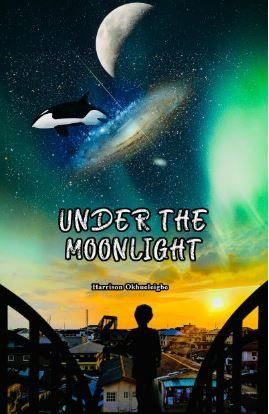
By Chukwuma Ajakah
US-based Nigerian creative artist and culture promoter, Harrison Okhueleigbe, in this auto-fiction with the sublime title, Under the Moonlight, takes the reader through the imaginary world of a child prodigy.
Set in a typical middle-class family of modern day Lagos, Nigeria, Under the Moonlight heralds present-day socio-economic realities, revealing a connection between the past and future from the perspective of a child whose intense imagination unfolds to make an interesting read as in the following excerpt: “My recent exploits of jumping off an eleven-floor wall while pretending to be Spiderman had left me with a dislocated wrist and had also left my mother impatient and anxious,… but I wanted to stay outside and daydream under the night sky.” However, the author infuses a traditional ambiance into the contemporary setting by incorporating the ancient culture of storytelling in the narration.
The plot structure of the novel revolves around the imaginative world of a young boy, Harrison Eghonghon through whom the author creatively relives his childhood fantasies. The secondary plot encapsulates a fictive world where spirits and unusual characters intermingle with human beings to establish a reality as commonly seen in folklores. The entire story is narrated from the point of view of a precocious child who presents the subject matter of each chapter in an informal conversional mode.
Published in 2022, Under the Moonlight is crafted into three broad parts, 125 pages and 13 chapters with subtitles, serving as guideposts to the reader. The author explores a wide-range of thematic concerns, including love for nature, celebration of cultural heritage, importance of ideal family relationships and child upbringing. The central theme of love for nature is primarily realized through the protagonist’s sentimental attachment to his natural environment, admiration for “the moon” and other “heavenly bodies” as well as creatures such as “owls” and “bats” which other characters in the novel seldom care about.
Cultural heritage, as a thematic preoccupation, is explored through the infusion of traditional storytelling devices as exemplified in the suspense filled mythical tales narrated by the protagonist’s grandmother, Nene. One such story is “Ojogbo Elimi” which runs from Chapter Six to Chapter Thirteen and features imaginary beings that epitomize diverse character traits prevalent in most human societies. Subtitles such as Dream and Imagination, Anticipation, The Arrival, Awakening, A Land Far, Far Away, The Unknown, Prisoner, Strange Voice, Reunion and Midnight Moon are embedded with inspiring wisdom nuggets that add to both the aesthetic quality and social relevance of the novel.
Moreover, the childhood days resonate with not only preteens and teenagers, but the adult reader, as it retrospectively represents a phase of life that is common to all. Besides, the narrator is the alter ego of the author, a lover of nature as depicted in: “I had spent the last four hours lying outside in the yard. For the first three hours, my family had been with me, receiving fresh air as most families in Nigeria do, especially during the six month-long West African dry season.”
Although the first-person narrative technique is the most predominant approach in the novel, the author integrates other devices such as the omniscient technique, story-within-story, suspense, dialogues and songs into the narration. Another fascinating device is the flashback which is reflected in the author’s ingenuity at recapturing and recreating his childhood experiences along with children-friendly settings. Although he admits that “Much of the story, including the folktale told by Nene, is a fictional account of the persona,” the use of his real name for the narrator and allusion to factual events and relationships help to create a make-believe setting, depicting the novel as a non-fictional narrative.
Characters in the novel include: the protagonist, Harrison, his immediate elder brother, Uwa and other siblings, his parents, grandparents and school mates. While these are portrayed as real members of the society, some fictive characters are also featured. In the fable narrated by Nene, his grandmother, fictive personae such as the seven-headed spirit, Ojogbo Elimi, Odigie, King Ojiso and his seven wives, play prominent roles as they contribute significantly to the development of the plot. There is also the “palm wine tapper”, Odigie who rescues the king’s only son, Onaiwu from the river where his father’s jealous wives had thrown him to drown.
Other captivating features of Under the Moonlight include the simplicity of its language and socio-cultural innuendoes that readers will find delightsome. To ensure international intelligibility, the author also provides explanations to complex linguistic elements such as vernacular and unfamiliar “Nigerian English” expressions.
Disclaimer
Comments expressed here do not reflect the opinions of Vanguard newspapers or any employee thereof.